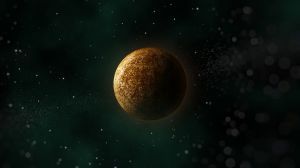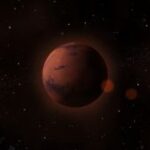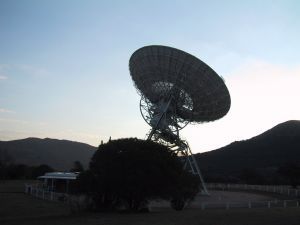A planet is a celestial body in our solar system, and from which there are different kinds. The two main types of planets are the Jovian and Terrestrial planets. The terrestrial planets are Earth-like and are more similar to Earth than Jovian planets. These Jovian planets include the Earth and its Moon, Venus, Mars and Mercury. These planets have variations from each other, including the aspects of atmosphere, pressure, temperature, surface features and the possibility of water.
First we should discuss the planet on which we compare to others and which we live, Earth. Of all the planets, Earth is very distinct. It is believe to have an age of 4.6 X 10^9 years. The shape is not round, but has an ellipsoid or a geoid shape. Earth is the third planet from the Sun in our solar system and the largest of the terrestrial planets. Obviously, we have the most known information on the Earth because we exist here. The Earth has an atmosphere, a layer of gas that surrounds the planet, and it is held together by gravity. This atmosphere contains Nitrogen, Oxygen, Argon, water and Carbon Dioxide. The pressure of the atmosphere is 10,330 g/cm^2, with a mean temperature of 10C. The Earth’s surface is very dynamic and is in two groups, continents of dry land and oceans. It is composed of silicate and basalt. Because of the plate tectonics (16 crust plates) due to the Earth’s center, we have earthquakes and volcano eruptions. Earth contains the most water out of any planet in the solar system, from the liquid ocean basins to frozen ice caps and vaporized water in the atmosphere.
We have the most information on the Earth’s moon, as compared to the moons of other planets. It is roughly 384,400 km away from Earth. It has many impact basins, ranging from small to 3,000 km wide. Along with basins, craters are very common on the surface. The temperature can range from 103K to 383K.There are some volcanic plains that were produced by lava, and also some mountain (basin walls and ejecta blankets.) In contrast to Earth, there is no plate movement, since the Moon is one plate and has no motion. There is no water on the moon, which indicates and very small chance for life on the moon.
Mars is a very interesting planet. The planet has been the focus point of alien life and other such science fiction myths. It is the fourth planet from the Sun, and can be referred to as the Red Planet, because of the appearance from Earth. The surface of Mars is thought to be made up of basalt. There is also a common believe that at one time, liquid water existed on the planet’s surface. There is no magnetic field on Mars, but some areas of the planet indicate that the crust was magnetized. Mars has some interesting surface features also. It has many impact craters and plains from lava flows. It also contains the highest mountain in the solar system, Olympus Mons, which is over three times the height of Mount Everest on Earth. Compared to the Earth, Mars has a thin atmosphere, which is dusty and gives the sky much different view than the Earth. The atmosphere contains Carbon, Nitrogen, and traces of Argon, Oxygen and Water. There is a high possibility of liquid water, not just frozen ice. Some evidence of photographs shows water. Earth and Mars are the most closely compared to when it comes to seasons, because of the similar tilts of the two planets, even though the seasons on Mars are twice as long as the seasons on Earth. In the winters, the temperatures can go to -220F in the winters to up to 70F in the summer seasons. Mars also has evidence that shows it has the largest dust storms of all the planets. It is said that when Mars is close to the Sun, the global temperature increases and can create these storms.
Venus is the second planet from the sun and the sixth largest planet in the solar system. It has an iron core and a mantle crust. Compared to the Earth, the rotation of Venus is slower. It is a little smaller that the Earth in comparison of diameter and mass, which shows why many claim that Venus is Earth’s sister. Not only are the sizes similar, but the surface of both planets have few craters, and the chemical makeup and density of the planets are close too. This connection to Earth could imply life, but is the opposite. Venus is said to be the least likely for life in our solar system. The atmosphere is much different than Earth’s. The pressure and density is immense and is composed of carbon dioxide. Clouds on the Venus contains mostly sulfuric acid and. Because of the density of the atmosphere, the greenhouse effect is multiplied from that of Earth’s. The temperature can reach 400 to 740 K. In comparison to Mercury, which is twice as close to the Sun, it is twice as hot showing the product of the greenhouse effect on Venus. Most of the surface is plains with some relief. It has a couple notable depression and highland areas. Venus could at one time have contained a huge amount of water, but was boiled away from the heat, leaving the planet very dry. It also has no magnetic field, but the interior of Venus is most likely similar is Earth. A very interesting effect with take place in 2012 and involves Venus. It is called the transit of Venus, and has not occurred since 1882. Venus passes between the Sun and Earth and appears as a huge black dot in the Sun.
The last of the terrestrial planets is Mercury, which is the smallest out of the four. It is the closest planet to the Sun and is the eight largest in the solar system. Like Venus, the main layers of the planet are an iron core and mantle crust. It is closely related to the surface of our moon, which means it has many craters. These craters range from small to very large diameters. It has a low magnetic field and has extreme temperatures compared to the Earth (temperatures can range from -292F to 802F.) The density is closely related to Earth also. Mercury, like Mars, has a thin atmosphere and contains hydrogen, oxygen, sodium and helium. The atmosphere is not stable because mercury is very small for its gravity and is difficult to retain any atmosphere. Mercury has a slow rotation and also a strong magnetic field, compared to some of the other terrestrial planets. Mercury has ice caps, but the planet contains a very small amount of water.
Why is space travel and exploration so hard? Why can we not live on other planets? There are many reasons as to why, most of them are very obvious. There are small amounts of oxygen and water, if any, on other planets. Along with this, the pressures and temperatures of the other terrestrial planets would make human life impossible. Living in space in general has many implications. Technical and human bodies are the two main obstacles. We may not have the technology today to sustain life in space in the aspect of the machines and craft. Our bodies are especially not suited for living in space, let alone other planets, no matter how similar to Earth they may be. The human body has a huge requirement for gravity, air and water. With no exercise in space, we would lose muscle tissue, which could result in organ failure. Medical News Today (www.medicalnewstoday.com) claims that other then the aspect of gravity on the tissue, space travel can change the natural body clock and would affect the astronauts. This shows that not only are there physical limitations and barriers, but psychological problems associated with space travel and living on other planets. Mankind has overcome obstacles before, and space is next. Many say space is the final frontier, and there is the possibility of human life on other planets with the right knowledge, which would not compare to today’s technology.
SOURCE:
Kaller, James. Astromony!. New York: Addison-Wesley,






